Senior technical editor Tom Marvin comes to the end of his time with the Merida One-Forty 6000. After a year of heavy use and memorable rides in the Alps and Finale Ligure, what are Tom's lasting impressions of this all-rounder trail bike?
Merida One-Forty 6000 long-term review conclusions
It feels like 2023 was a bit of a turning point for Merida, when it came to the brand's trail and enduro bikes. I first rode the One-Forty and One-Sixty at their launch, and immediately realised Merida was onto something good.
The geometry was contemporary-verging-on-radical, there were smart component choices across the price range and, most importantly, the ride feel was both confidence-inspiring and grin-inducing.
How good the bikes were was only confirmed during our Bike of the Year testing. The cheaper, alloy version of the One-Forty (with the same build kit as my long-termer) won Trail Bike of the Year, while Rob loved the One-Sixty enough to give it the win in the enduro category.
Merida has since bolstered its impressive range with the new One-Twenty.
With the year having drawn to a close, the One-Forty 6000 is on its way back to Merida for a new lease of life (after a decent service) under one of the brand's UK staff.
My enduring memories of the bike will probably be travelling to both the Alps and Finale Ligure with it, where I was able to give it the absolute beans. It just came back asking for more.
Merida One-Forty 6000 highs
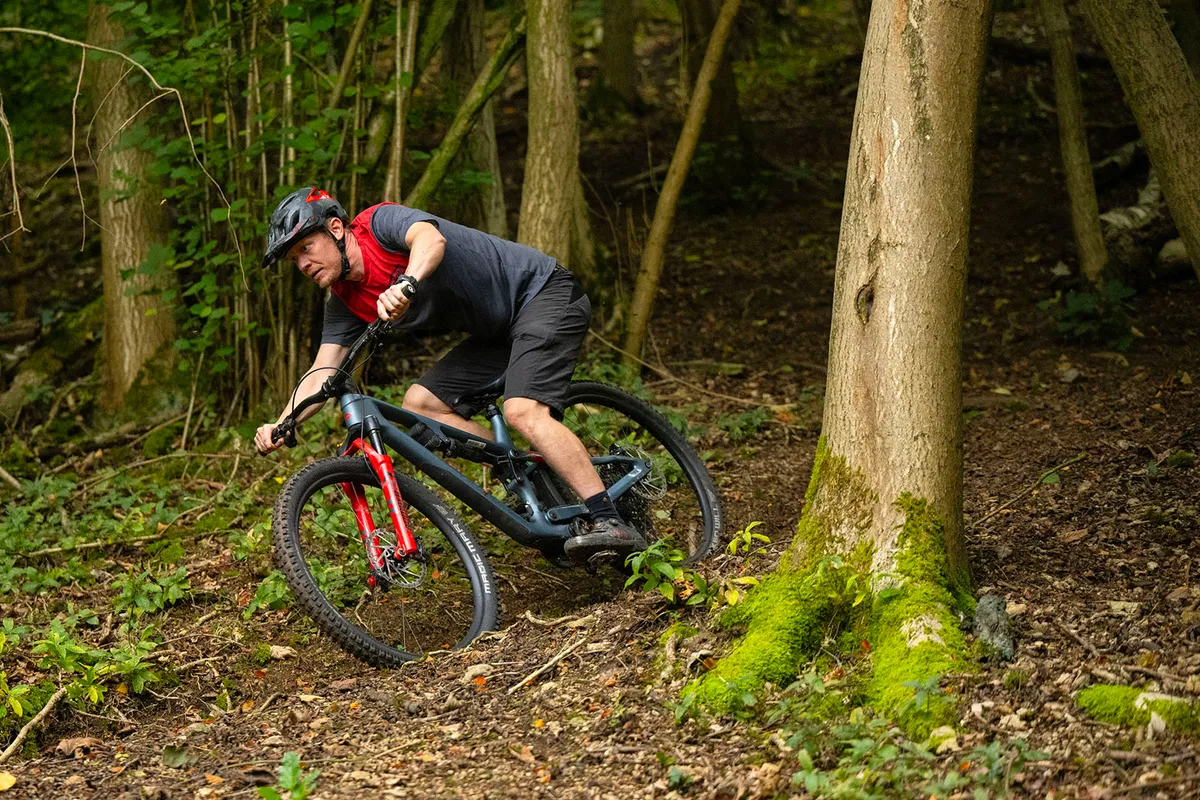
I’ve been really fortunate that, mechanically, the One-Forty has stood up to a year of hard use. Nothing notable has failed mid-ride, I’ve had zero punctures and the only time I’ve used the OneUp EDC tool has been to lend a hand to riding pals.
The chassis – and I include the suspension in this – has lasted the distance, reliably plugging away week in, week out.
I won't deny that I’m a little maintenance-phobic. However, with a few handy workshop tools – including a small battery-operated drill to whizz rotor bolts in and out – I’ve spent more time recently sipping tea with a smug look on my face than I have turning the air blue with my spanner-based frustrations.
Merida One-Forty 6000 lows
Although virtually faultless, the RockShox Deluxe Select+ rear shock was the weakest link.
On rough descents, the single-can shock would heat up noticeably, to the point where I could feel the warmth through my knee pads.
This would cause the damping to speed up on long descents, changing the bike’s ride characteristics.
Although fixing this issue is relatively easy by replacing the shock for a piggyback version, it’s not going to be a cheap upgrade.
Merida One-Forty 6000 long-term review verdict

The One-Forty 6000 is a fantastic all-rounder that can be morphed between the trail bike bell curve extremes with careful spec choices to shed weight or add stability, such as wheel and tyre upgrades.
That makes it suited to trundling around fireroads and flowing singletrack at your local woods through to handling gnarly winch and plummet enduro-style descents.
Although I may not have purchased it myself, I have recommended that my best mate go and buy one – not a decision I took lightly, because if he doesn’t like it, I’ll get it in the neck!
Merida One-Forty 6000 in brief
The Merida One-Forty model was launched in 2022, and represents perhaps one of the most radically shaped trail bikes on the market. I hope Merida wouldn’t take umbrage at me saying that’s a sentence I wasn’t expecting to write when I first heard a new model was on the way.
As you might expect from the name, the One-Forty has around 140mm of travel at the back (it’s actually 143mm), and this is paired with a 150mm fork.
The 6000 model is the cheapest carbon One-Forty and represents what can only be described as ‘really good value for money’, in my opinion.
Other than the geometry and good value, there are a couple of noteworthy spec details I’m sure will come up in discussion as the year progresses.
First of these is the routing of cables through the headset, something that doesn’t lend itself to my maintenance-phobic attitude to bike ownership. Then there's the unique 30 to 230mm adjustable dropper, the backbone of Merida's geometry concept.
The One-Forty shares the same frame as Merida's longer-travel One-Sixty enduro bike. Longer forks and a longer stroke shock boost travel on the bigger rig.
Older updates follow
Merida One-Forty 6000 long-term review update two – the Ex Enduro experience

As summer ends, I traditionally enter the Merida EX Enduro on Exmoor, in the South West. This year, we were greeted on the Friday by amazing trails, with Exposure Lights equipping me with a couple of high-powered units for the three night-ride stages.
The weather turned on Saturday, with the longest day (40km and 1,600m of climbing) starting in the mist and continuing through muddy conditions. It’s safe to say that my mates and I took a while to make it back to camp.
Sunday was truly biblical, with thunder and lightning providing a wake-up call as I crawled out of my van, accompanied by relentless rain.

With many of the trails turned into rivers, the stages ran faster in the wet than in the mud of the previous day, and once my waterproofs had been breached, there was no reason to avoid the puddles.
Props have to go to the organisers, who still put on quite the spread mid-way through each day – a cracking cream tea to refuel us mid-loop. Turns out that scones with jam and cream are top-tier race fuel.
My One-Forty performed faultlessly as I’ve come to expect. I felt pretty smug rocking up on the damp days with an ADDIX Ultra Soft-compound Schwalbe Magic Mary up front – I reckon there wasn’t a more suitable tyre on the start line.
The blocky tread digs into slop almost as well as a dedicated mud spike, while the soft rubber gives mega grip on wet roots.
While I did slide around, I’m sure I’d have placed lower with a different tyre.
Merida One-Forty 6000 long-term review update one – making a new friend
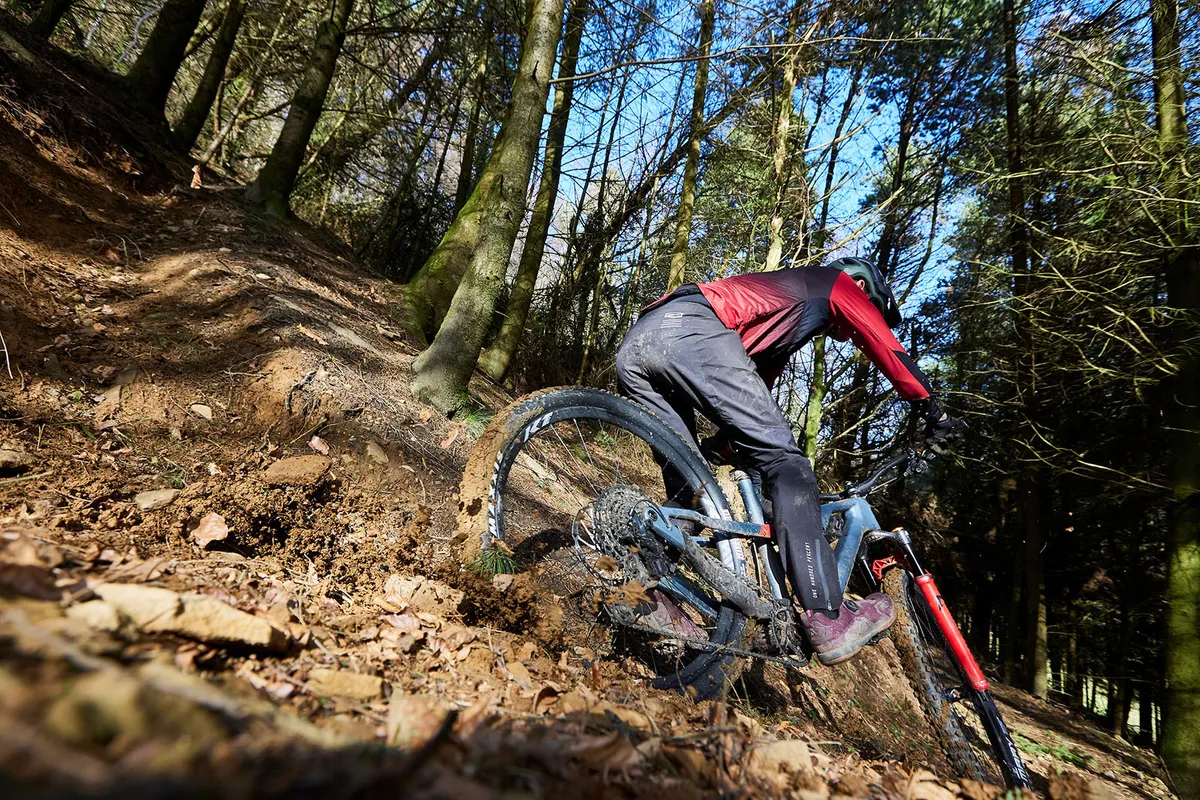
After only a month on the One-Forty, it grew on me massively. While I’ve been lucky
to have had some great long-termers, only two have been bikes I’ve really loved – my 2017 Transition Scout and my 2021 Marin El Roy. Quickly, though, the One-Forty has burrowed its way into my heart.
Swapping the stock Shimano SLX brakes wasn’t as bad as I initially feared; forced to explore the daunting world of through-the-headset hose routing, I was really happy that I only swore on three occasions when swapping the stoppers.
Fully guided hose runs really do make life much easier.
Feeling closer to home
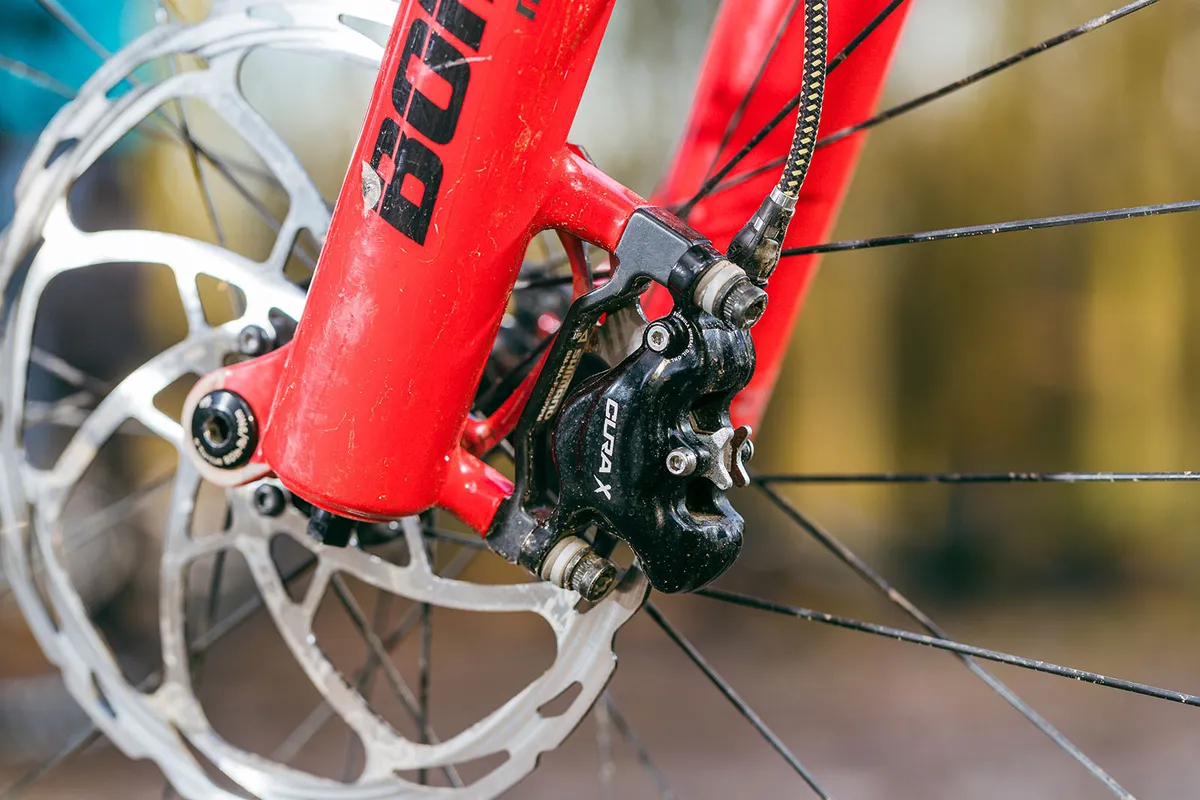
To help make it feel like my bike, I fitted my favourite grips, Santa Cruz’s Palmdales, and swapped the long 50mm stem for a 40mm number I found in the garage, to speed things up and bring a bit more agility to the handling.
The 10mm change made a noticeable difference – turning into a corner feels lighter, the bike is quicker to ‘drop its shoulder’ and feels overall like a tighter package.
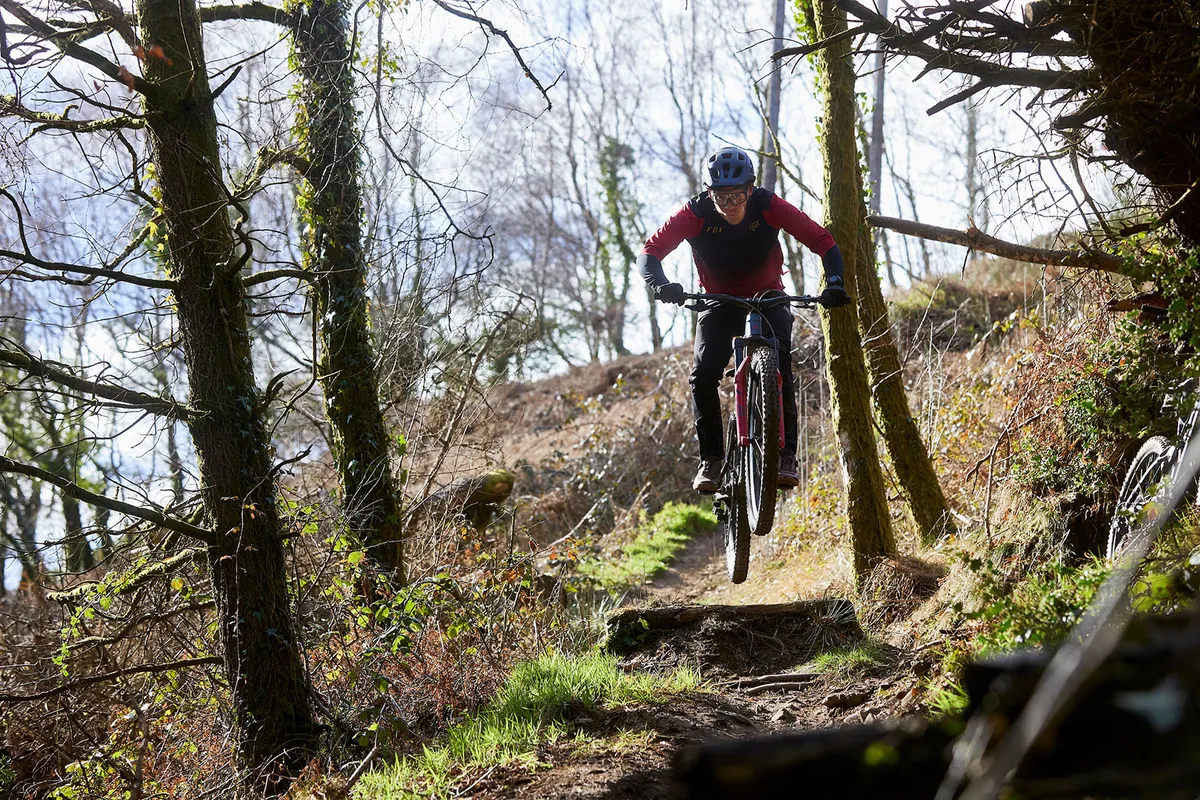
On-bike storage is in vogue, and the Merida has it in spades. There’s a long umbrella-shaped roll that can be slid up the down tube; a tube holder under the top tube; a multi-tool under the saddle; and a rear-axle lever that doubles (or triples!) as a 4mm and 6mm Allen key.
The multi-tool and axle tool haven’t survived my purge. Instead, I’ve stuffed a different tool down the fork steerer.
Parts swap
After a problem with the rear RockShox Deluxe Select+ shock, I managed to get my hands on a new one from Merida, this time with a lighter tune. The supplied shock made the bike grippier in marginal conditions, but with a tad more movement on climbs. Given how well it goes uphill, I wasn’t too worried.
Along with a new rear shock, I was lucky enough to be an early adopter of SRAM’s Transmission, in the XX SL guise.
This flyweight drivetrain is only offered with a 34t chainring, which is two teeth bigger than the one previously fitted.
Because the top of the new ring sits higher over the main pivot, it’s reduced the amount of anti-squat built into the bike’s suspension, making it much more active on pedally climbs. So, I’ve been using the shock’s lockout more.
The flipside is that the bike feels even smoother and traction is at an all-time high. With sturdy tyres, the One-Forty feels like a mini enduro bike.
Merida One-Forty 6000 specification and details
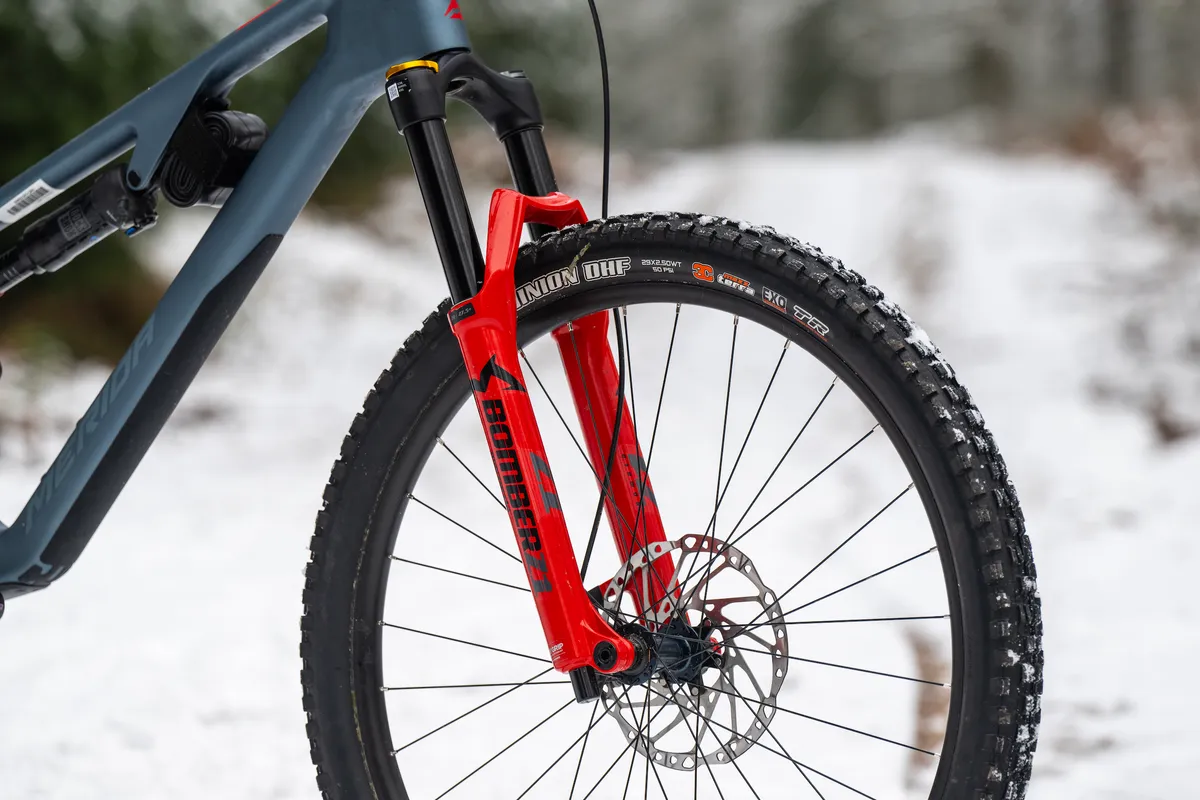
I’ll start with the headlines.
At the front is a Marzocchi Z1 suspension fork, with 150mm of travel. It’s an air-sprung model and features the Rail damper. It’s almost a Fox Rhythm 36 in disguise (Fox purchased Marzocchi a few years ago), and none of these facets are a negative, in my opinion.
Further back is a RockShox Deluxe Select+ shock. It, too, is air-sprung, and features a lockout and rebound control.
The bulk of the drivetrain comes from Shimano. Most of it is solid SLX kit. However, I’m impressed to see an XT shifter – the most important part of any drivetrain in my opinion, and a real upgrade over the SLX model, thanks to its dual-release thumb paddle and overall feel.
Cranks from Race Face and a chain from KMC complete the picture.
Shimano’s SLX 4-piston brakes decelerate the bike effectively, thanks to 203mm rotors at each end. For context, this is still classed as a trail bike. Clearly, braking power is important to the Taiwanese brand (and its German engineers).
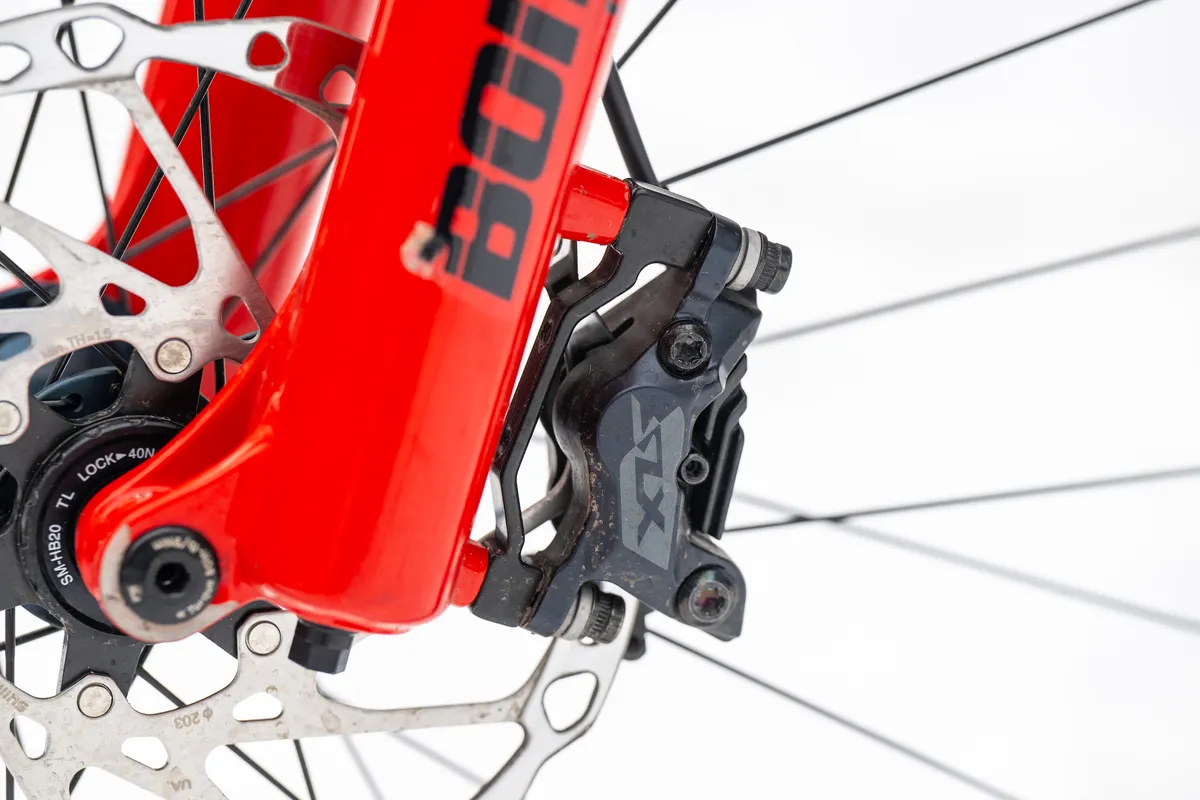
Merida’s own rims spin on fast-engaging SLX hubs, while Maxxis provides some decent rubber, including a relatively strong EXO+ rear casing.
Finishing kit comes from Merida, too, including that aforementioned dropper. Its (admittedly) rather clunky box on the side enables you to adjust the amount of travel on offer between 30 and 230mm. This means you're able to pick a range of model sizes to satisfy your bike-length requirements.
Finally, there’s a headset through which the cables are routed. I’m not exactly thrilled at the prospect of working on this, but at least it gives the bike moderately clean lines.
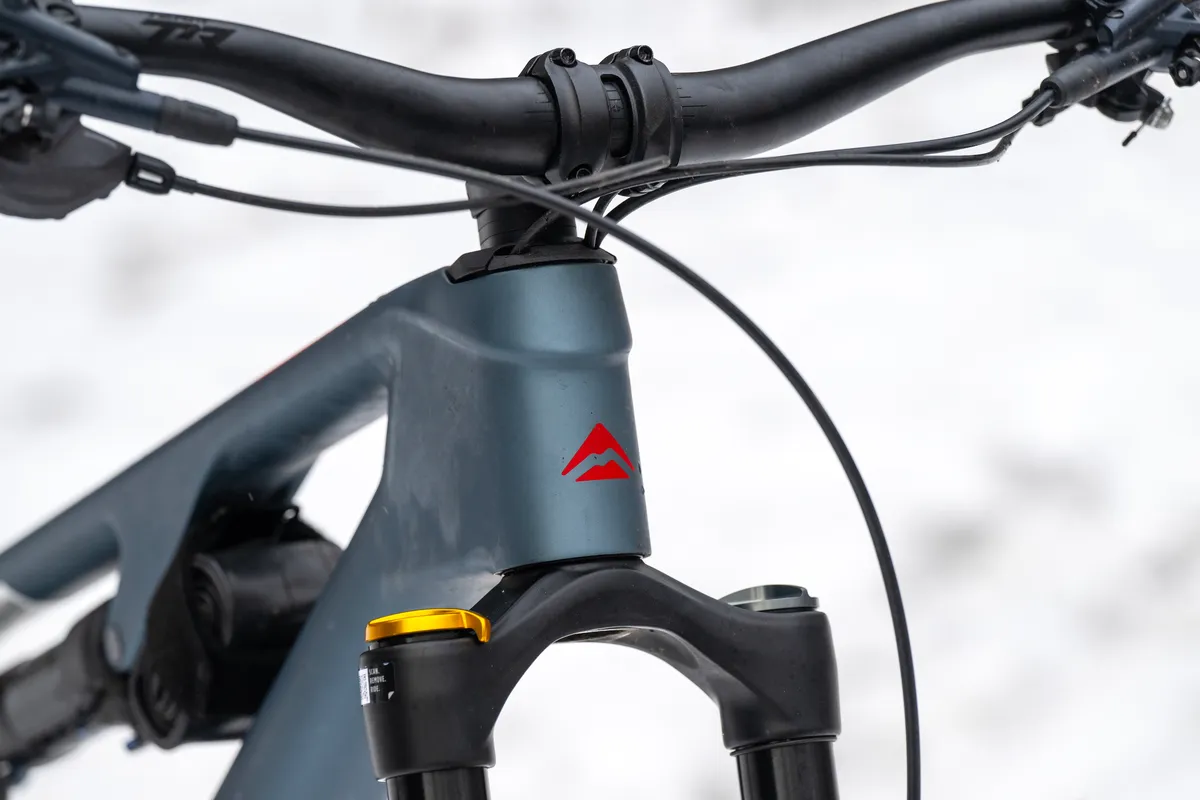
Merida One Forty 6000 full specification
- Sizes (*tested): XShort, Short, Mid, Long*, XLong
- Frame: One-Forty CF4 III, 143mm travel
- Shock: RockShox Deluxe Select+ Plus
- Fork: Marzocchi Z1, 150mm travel
- Shifters: Shimano XT
- Derailleurs: Shimano SLX
- Cranks: Race Face Turbine 32t
- Wheelset: Merida Expert TR on Shimano SLX hubs
- Tyres: Maxxis Minion DHF 2.5 WT 29X2.5in EXO (f) and Maxxis Dissector 2.4 WT 29X2.4in EXO+ (r)
- Brakes: Shimano SLX 203/203mm rotors
- Bar: Merida Team TR, 780mm
- Stem: Merida Expert eTRII, 50mm
- Seatpost: Merida Team TR 30-230mm
- Saddle: Merida Expert SL
Merida One-Forty 6000 geometry
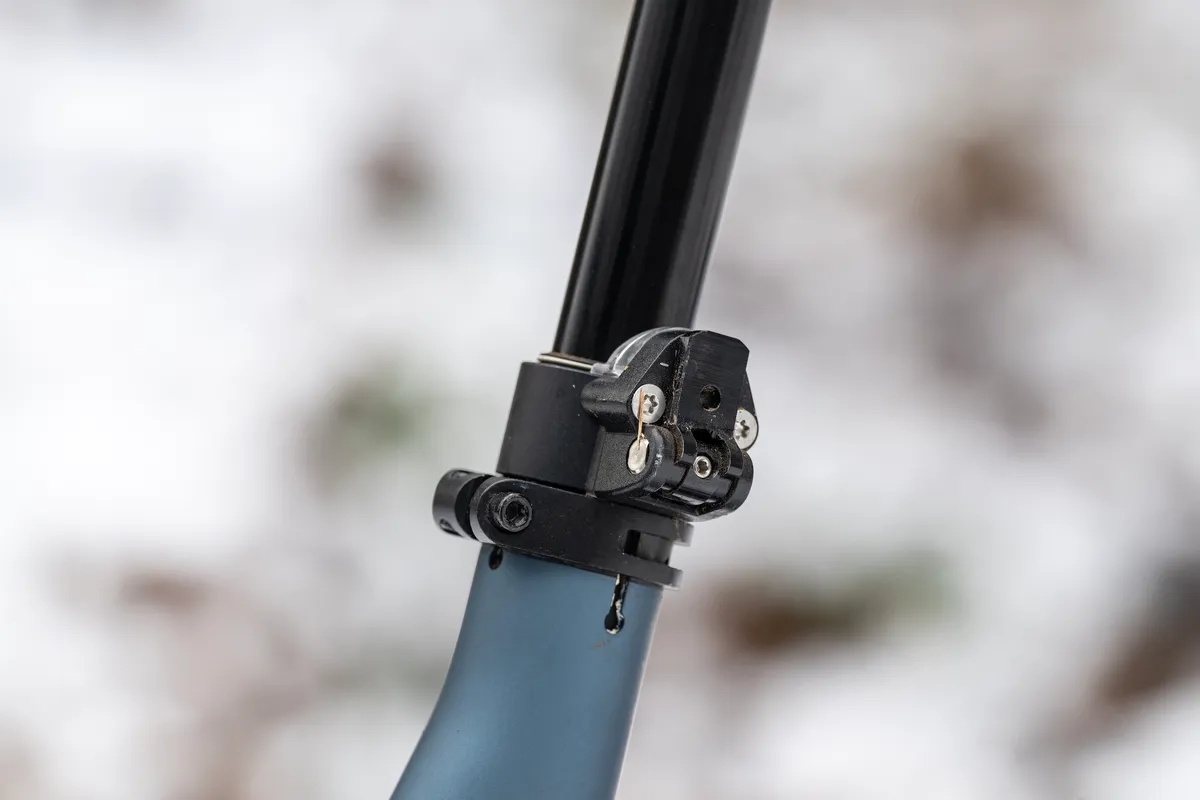
I’ve got the ‘Long’ model, which equates roughly to a Large… in some respects. Basically, it’s the size down from the biggest, which is what I’d usually choose.
There are five sizes on offer, and if reach is the figure by which you judge a bike, the range from 426mm to 535mm will raise some eyebrows. Those are some seriously long reaches (with healthy gaps between sizes).
These tally with seat tubes that range from 400 to 470mm – not exactly long in the grand scheme of things.
My size-Long bike has a 509mm reach and a 445mm seat tube. That’s seriously long – longer than the Marin El Roy I loved so much. However, with a near 80-degree seat tube angle, the saddle-to-bar reach fortunately doesn’t cover quite the same acreage.
Other figures to be aware of are the 65-degree head angle (not the slackest ever, but hardly steep) and the mid-length 437.5mm chainstays that are consistent across all the sizes.
Other nerdy numbers can be gleaned from the geometry chart below, if that’s your thing.
| FS Frame Size | X Short | Short | Mid | Long | X Long |
|---|---|---|---|---|---|
| Tyre size (in) | 29/29 | 29/29 | 29/29 | 29/29 | 29/29 |
| Seat tube (mm) | 400 | 410 | 425 | 445 | 470 |
| Top tube (mm) | 532 | 559 | 586 | 618 | 649 |
| Chain stag length (mm) | 437.5 | 437.5 | 437.5 | 437.5 | 437.5 |
| Head tube angle (degrees) | 65 | 65 | 65 | 65 | 65 |
| Seat tube angle (degrees) | 80 | 80 | 80 | 80 | 80 |
| Bottom bracket drop (mm) | 35 | 35 | 35 | 35 | 35 |
| Head tube (mm) | 95 | 95 | 95 | 105 | 120 |
| Fork length (mm) | 557 | 557 | 557 | 557 | 557 |
| Reach (mm) | 426 | 453 | 480 | 509 | 535 |
| Stack (mm) | 607 | 607 | 607 | 616 | 629 |
| Wheelbase (mm) | 1,177 | 1,204 | 1,232 | 1,265 | 1,298 |
| Standover height (mm) | 722 | 725 | 732 | 731 | 771 |
Why did I choose this bike?

I attended the launch of the Merida One-Forty and One-Sixty, held just before The Ex Enduro (supported by Merida and Shimano Steps).
I’d had a sneak peak of the bikes ahead of time, so knew the One-Sixty was going to be fairly radical, but I didn’t grasp that the One-Forty would fall from the very same tree.
While I’m happy riding longer-travel bikes, I do rather like the mid-travel trail bike genre. I like taut bikes that pedal well and don’t feel like an under-ripe blancmange.
It seems 2022 was a vintage year for the more aggro-trail bike, with both the Fuel EX from Trek and the Scott Genius subscribing to my MTB ideals, as well as the One-Forty.
As such, it was definitely one of these bikes that I wanted in my garage for 2023.
Merida One-Forty 6000 initial setup

Setting up the bike was fairly easy – I set the suspension at around 20 per cent sag for the fork and 25 to 30 per cent at the back (I like to play around a bit, anyway).
Rebound is usually pretty much as open as it goes for me – I like a quick-feeling bike. There’s no compression adjustment on either suspension unit.
I run my brake levers moderately flat, and I don’t have massive hands, so my shifters are pretty close to the grips. The dropper uses a Shimano lever, and so cockpit setup is nice and easy.
Setting the dropper’s height isn’t overly intuitive, though there’s a good video on YouTube to walk you through it. Having spoken to Merida, it’s really important to follow it carefully to avoid wearing out the little orange cord that determines how the adjustable travel operates, especially out of the box.
I’ve heard a rumour that there’s a new version of the dropper on the way, so if you’re buying this bike later in 2023, yours might look and operate differently from mine.
Tyres are set at my usual pressures – around 23psi at the back and 20 at the front.
I’m running my favourite Nukeproof Horizon CS clipless pedals on the bike.
Merida One-Forty 6000 ride impressions

I’ve not had masses of time on the bike yet, so excuse my brevity.
However, I have gleaned a few things from the riding I’ve done.
First up, the suspension is absolutely solid under power. There aren’t many mountain bikes, especially aimed at the trail market, that are so stable under regular pedalling forces.
This means the bike feels efficient and easy to ride, and I’ve rarely felt the need to flick the lockout switch on the shock.
On flatter, rolling trails, this plays into the bike’s advantage, too, because it’s easy to accelerate up to speed with a few pedal strokes that don’t rob power.
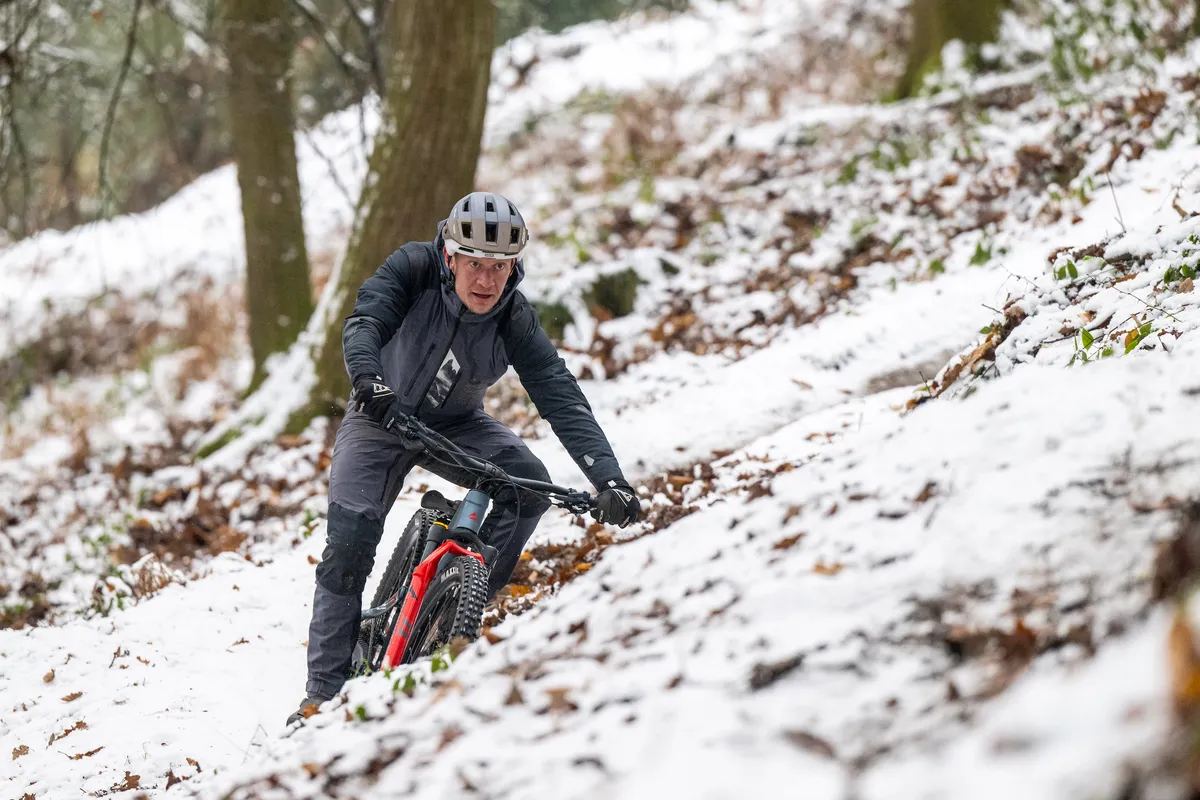
Of course, standing on the pedals and mashing them does result in some bob, but that’s par for the course on any full-suspension bike.
There is a bit of a trade-off with these pedalling manners. It’s not the smoothest bike ever. If you like complete isolation from the ground, the rear suspension might not be quite to your tastes.
This doesn't mean it’s harsh, or uncontrolled, but it’s not a smooth, sofa-like bike to ride.
The length of the bike, plus its stable and supportive suspension and moderately slack head angle, means it’s a complete weapon in steep tech. It feels unshakeable when pointing down horribly steep terrain (especially if you have weather-specific treads – more on that in a future update).
The 203mm rotors and SLX calipers combine to offer ample power and control, too. Confidence, then, is at an all-time high.

It’s not all roses and popcorn, though.
The 50mm stem is too long for a bike that’s got ample stability from its long reach. A shorter stem should quicken handling a touch. At the same time, as I’ve mentioned time and time again, 780mm bars on a trail bike are a mistake.
Give us 800mm bars and let those who want something narrower chop them down, please. I’ll be fitting some bars that fit my frame, soon.
Merida One-Forty 6000 upgrades
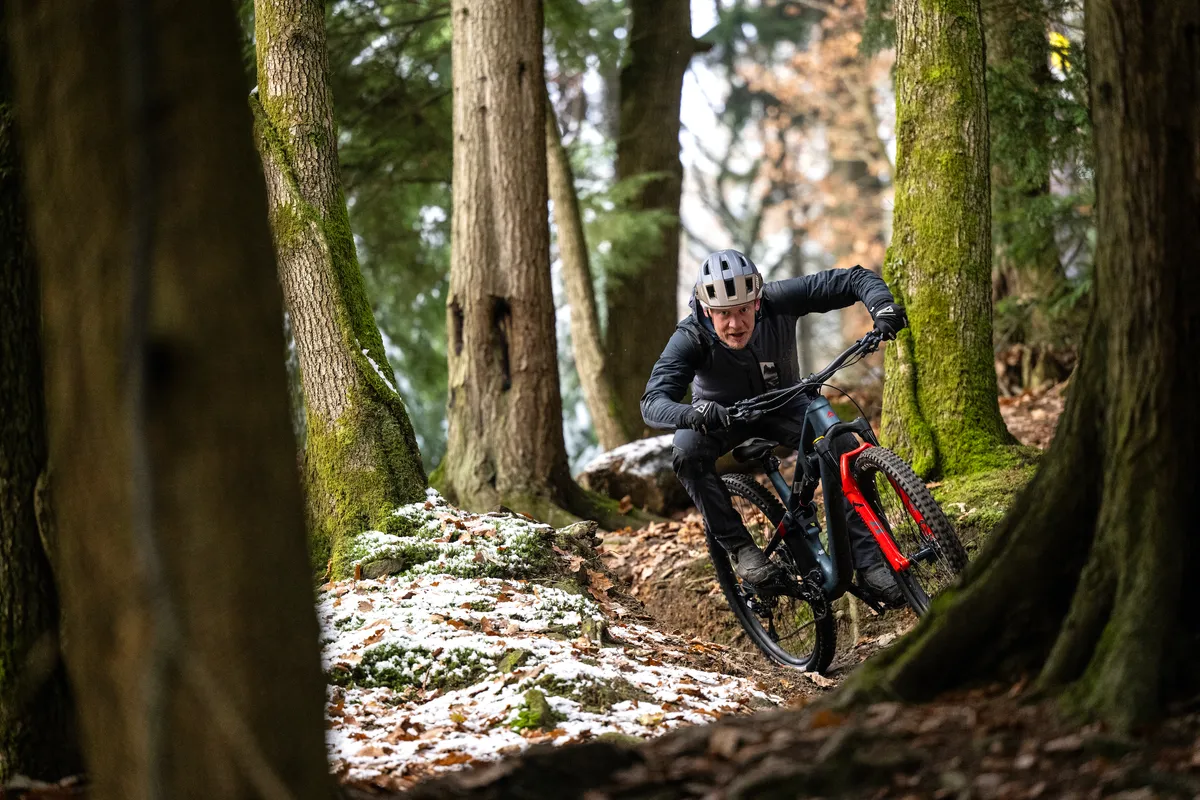
I’ve already given you a taste of what I might change down the line.
A shorter 40mm stem will be the first upgrade to the bike to sharpen its handling. And, if I can find something in the garage, an 800mm bar will go on there at the same time.
I’m a big fan of getting the right rubber for the right situation, too. Down in the South West of England, we’ve a broad range of terrain, and so while the Minion is a reliable all-rounder, I’ll be looking to my collection of mountain bike tyres for something more situational.
There are a few other changes that’ll almost certainly make their way onto the bike.
I’m not going to be able to dodge the internal (infernal?) cable routing, because a set of Formula Cura X brakes are destined for testing. We’ll see how easy that is.
And, as you’ll have heard, there are some new goodies from SRAM knocking about. It’d be remiss of me to not attempt to get hold of some of them for myself.
BikeRadar‘s long-term test bikes
BikeRadar's long-term test bikes give our team the opportunity to truly get to grips with these machines, so we can tell you how they perform through different seasons and on ever-changing terrain, through a year of riding.
Some choose a bike from their favoured discipline and ride it hard for a year, others opt for a bike that takes them outside of their comfort zone.
We also use our long-term bikes as test beds for the latest kit, chopping and changing parts to see what really makes the difference – and help you decide which upgrades are worth spending your money on.
These bikes also provide an insight into the team's riding through the year – how they like to ride and where life on two wheels takes them, from group rides on local lanes and trails, to adventures further afield.
To see all of the BikeRadar team’s long-term test bikes – and to stay up-to-date with the latest updates – visit our long-term review hub.
Product
| Brand | Merida |
| Price | £4500.00 |
Features
| Fork | Marzocchi Z1 |
| Stem | Merida Expert eTRii |
| Chain | Shimano SLX |
| Frame | One-Forty CF4 III |
| Tyres | Maxxis Minion DHF 29x2.5 EXO, Maxxis Dissector 29x2.4 EXO+ |
| Brakes | Shimano SLX |
| Cranks | RaceFace Turbine |
| Saddle | Merida Expert SL |
| Wheels | Merida Expert TR, Shimano SLX |
| Headset | Merida 8151 |
| Shifter | Shimano XT |
| Cassette | Shimano SLX |
| Seatpost | Merida Team TR |
| Grips/tape | Merida |
| Handlebar | Merida Team TR |
| Rear shock | RockShox Deluxe Select+ |
| Bottom bracket | RaceFace |
| Available sizes | XShort, Short, Mid, Long, XLong |
| Rear derailleur | Shimano SLX |
